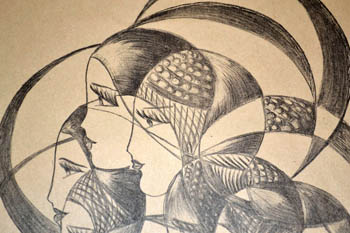Product Description
Jean E. Puiforcat / French Art Deco Sterling Box c.1930


JEAN E. PUIFORCAT (1897-1945) France
ORFÈVRERIE PUIFORCAT Paris, France
Sterling silver with sterling and bone gear-like finial detail
Marks: JEAN E. PUIFORCAT, French Guarantee mark for 950/1000 pure silver, E.P. insignia (Emile Puiforcat)
For related works of Puiforcat see: Jean Puiforcat, Françoise de Bonneville (Paris: Editions du Regard, 1986) p.171; Jean Puiforcat: Orfèvre Sculpteur (Paris: Flammarion,1951).
H: 3 1/4″ x Dia: 3 1/2″
Jean E. Puiforcat is the most famous name of Art Deco silverwork. This is a gently tapered round footed and covered box of beautiful form and proportion with a contoured gear-like bone and silver finial. Overall it is a signature example of French Art Deco silver and dates from the late 1920’s and bears the early mark of Jean E. Puiforcat spelled out in addition to all of the appropriate French silver standard touchmarks. It is a really perfect example of French Art Deco silver by the French master of them all, Puiforcat!
Jean E. Puiforcat / French Art Deco Sterling Box c.1930
Cartier Art Deco brooch, carved rock crystal with a fancy platinum mount set with two European and cushion cut diamonds (approx. 3 carats TW) further set with two European and cushion cut diamonds (approx. 1 carat TW) with diamond pave work filling out the surrounding floral motif, original leather box, signed and numbered, c. 1925
TIM LIDDY
“Monopoly” (1936) A Parker Trading Game 2007
Oil and enamel on copper, plywood back
Signed in script: Tim Liddy “circa 1936” 2007, red circular ring
Provenance: Kidder-Smith Gallery (Boston, MA)
H: 7 5/8” x W: 6 ½” x D: 1 ½”
With his recent paintings, Liddy has both reasserted the construct of hyperrealist painting and developed a thoroughly unique advancement of that mode by extending the cultural reality of the indexed original. Based on the illustrated box lids of vintage board games, Liddy has recontextualized a subject, which evokes the underlying rules of life. Painted on copper or steel in the precise dimensions of the original, the metal is then manipulated to demonstrate the exact rips and tears from years of usage and includes trompe-l’oeil renditions of the scotch tape that might be holding the cardboard box together, the assorted stains, or the various graffiti of time. Liddy leaves no possibility of ambivalence, these works speak to a concurrent understanding of their original object identity and to themselves as works of art engaged in historical and psychological dialogue.
